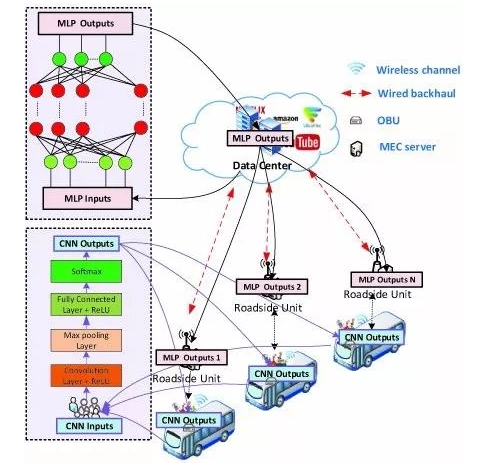Once self-driving cars become a reality, passengers no longer worry about safety issues, they need to find new ways of entertainment. However, the high latency of vehicle-to-data center (DC) communications will hinder the retrieval of entertainment content from content delivery services. This paper proposes a deep learning-based cache for autonomous vehicles by using the deep learning method deployed on the multi-access edge computing (MEC) structure. Through the simulation test, it is found that this method can minimize the delay.
Recently, autonomous driving technology has made significant progress. Some companies, such as Google, Uber, Samsung, Tesla, Mercedes-Benz, Baidu, etc., have begun to pay attention to the next stage of autonomous driving—"unmanned "Driving" means that the car can drive autonomously without human intervention. In addition, in order to make self-driving cars more intelligent, cars need to be equipped with smart sensors and analysis tools to collect and analyze heterogeneous data related to vehicle personnel, pedestrians and the environment in real time. Deep learning plays an important role.

The importance of multi-access edge computing in the future
Even if an autonomous vehicle has an on-board unit (OBU) that handles computing, communication, buffering, and control (4C), 4C's autonomous vehicle resources are still limited and require assistance from a remote cloud. For effective self-driving car data analysis, low latency and reliable calculations are required. However, due to the associated end-to-end latency, reliance on the cloud may affect the performance of autonomous vehicle data analysis. Therefore, in order to reduce end-to-end latency, we regard Multi-Access Edge Computing (MEC) as a technology suitable for supporting autonomous vehicles for edge analysis. MEC was recently launched by the European Telecommunications Standards Institute (ETSI) to complement cloud computing, where MEC servers are deployed at the edge of the 4C network. In this work, the MEC server is deployed on RoadSide Units (RSU) for edge analysis and content caching near autonomous vehicles.
Through the deep learning and 4C functions of self-driving cars, passengers will no longer be limited to in-car radio and TV, but spend more time watching media, playing games and social networks. However, due to the associated end-to-end delay and the backhaul bandwidth resources consumed, retrieving this content from the data center (DC) can make the content delivery service worse. As an example, watching a video in a car requires three components, namely the video source, the screen and the sound system. Therefore, if the video source is not in the car, the car needs to download from DC. Assuming that the DC is located far away, the in-car service will have high latency, and the cache in the self-driving car will play an important role in improving the user experience.
The challenge of self-driving car caching
For people traveling, self-driving cars will become a new place of entertainment. Therefore, content providers and game developers need to seize this new opportunity by providing high-quality entertainment content. However, there is still a lack of literature on how to perform caching of entertainment content in autonomous driving.
Self-driving cars can provide more heterogeneous entertainment content, such as movies, TV, music, and games, as well as platforms that have recently emerged, such as virtual reality (VR). However, 4C's self-driving car resources are limited. Therefore, the MEC server needs to support autonomous vehicles.
Self-driving cars are sensitive to delays. Therefore, to reduce car-DC delay and save backhaul bandwidth, it is necessary to strengthen and optimize the use of communication and cache resources in MEC servers and autonomous vehicles.
There has been no good answer on how to solve the problem of self-driving car cache.
Autopilot cache based on deep learning
In order to solve the above-mentioned challenges, Anselme Ndikumana and others from the Department of Computer Science and Engineering at Kyung Hee University in South Korea suggested the use of deep learning-based caching and the 4C method in MEC to improve entertainment services in autonomous vehicles.
Their main methods are summarized as follows:
Passengers have different content preferences, and their choice depends on age and gender. In order to meet the needs of passengers in self-driving cars, a Convolutional Neural Network (CNN) method is used to predict their age and gender through facial recognition. Specifically, CNN output is used by self-driving cars to determine which entertainment content (such as music, video, and game data) is suitable for passengers and therefore needs to be cached.
To provide passengers with appropriate entertainment content, MEC and DC are required to support autonomous vehicles. At DC, they proposed a MultiLayer Perceptron (MLP) framework to predict the probability of requesting content in a specific area of ​​a self-driving car. Then, the MLP prediction output is deployed at the MEC server (RSU) next to the autonomous vehicle. During off-peak hours, each MEC server uses MLP output to download, and then caches content with high request probability. Choosing MLP is superior to other forecasting methods, such as AutoRegressive (AR) and Autoregressive Moving Average (ARMA) models. MLP has the ability to deal with linear and nonlinear forecasting problems.
For the content that needs to be cached, the self-driving car needs to download the MLP output from the MEC server, and then compare it with the CNN output. For comparison, this method also combines k-means and binary classification.
Use 4C components in MEC for deep learning, and develop caches for entertainment services in autonomous vehicles to minimize content download delays.
Today, when the autopilot technology is not fully mature, the technology of autopilot caching studied in this article is still far away, but the methods and research ideas proposed in it are still worth learning. According to the survey, this is the first article to study the caching of entertainment content in autonomous vehicles, where caching decisions are based on MLP, CNN, and available communication, caching, and computing resources.
Ic Pmic,Pmic Full Half Bridge Drivers,Pmic Gate Drivers,Integrated Circuits Ics Pmic
Shenzhen Kaixuanye Technology Co., Ltd. , https://www.icoilne.com